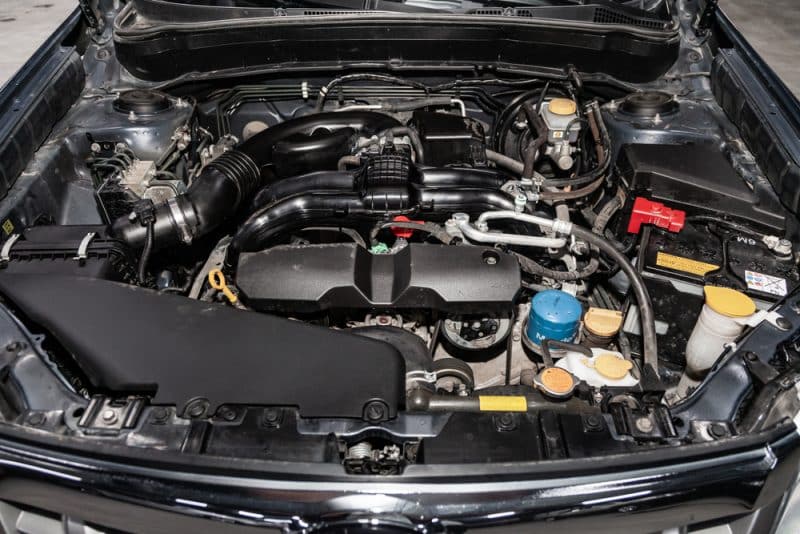Ford 4.6 Cylinder Head Temperature Sensor?
The performance of the engine is chiefly dependent on temperature readings. The work of the cylinder head temperature sensor is to note these readings.
The engine control module receives these readings to regulate the engine’s temperature to keep things running smoothly.
This article will explore how the cylinder head temperature sensor operates.
A car’s engine regularly monitors its temperature, and its operation hinges on this key element. The Ford 4.6 Cylinder head temperature sensor monitors temperature by taking readings from the engine’s metal. These readings help regulate the temperature by using an Engine Control Module (ECM). The ECM is responsible for controlling the temperature and ensuring the smooth running of the engine.
What Does The Cylinder Head Temperature Sensor Do?

The cylinder head temperature sensor has a fundamental purpose in the car.
The sensor reads the temperature of the cylinder head and indicates to the driver if the engine is overheating.
It is mostly utilized on air-cooled engines. The head temperature gauge identifies the engine’s work quicker than a water or oil temperature gauge.
Whenever a car is moving, the engine does a lot of work, raising its temperature.
Since performance depends on the engine’s temperature, the engine keeps a check on the temperature.
The Engine Control Module (ECM) serves as the brainbox of the engine. The ECM regulates the temperature so the car can run without issue.
Let’s take, for instance, the engine has a cold temperature, and you wish to start the car. Starting will require more petrol than usual.
On the other hand, in the case where the temperature of the engine is hot, the ECM may need less petrol or more coolant. The purpose of this is to sustain high efficiency and safety.
So now, the component that monitors the engine’s temperature for the ECM is the cylinder head temperature sensor.
The cylinder head temperature sensor connects directly to the engine’s cylinder head. It can read temperatures between -40°F and 500°F.
An essential attribute of the cylinder head temperature sensor is that it collects its reading right from the engine’s metal.
This attribute contrasts with other designs like the Engine Coolant Temperature (ECT) sensor.
The ECT sensor’s readings are dependent on the coolant’s temperature in which it is submerged.
The sensor’s convenience can’t be understated; they prevent the engine from wasting petrol or stalling.
In addition, the cylinder head temperature sensor provides precise and credible readings.
How Do I Know If My Cylinder Head Temperature Sensor Is Bad?
With its unique functionality, the cylinder head temperature sensor can malfunction.
Therefore, it is good to be aware of any indications that suggest that the cylinder head temperature sensor needs replacing.
Reading cylinder head temperatures is crucial for correct engine calculations.
Therefore, if the sensor is down, it can result in overheating, total engine failure, petrol inefficiency, and engine stalling.
The following can help you discover a bad cylinder head temperature sensor.
- Lengthy cranking time as you attempt to start your car.
- A decline in the petrol economy.
- A decline in acceleration.
- The check engine light indicates.
- The car jerks forward whenever you accelerate.
There are varying reasons for malfunction; however, some signs can identify particular problems, unlike others.
Good knowledge of these signs and their indications might help save you money in repair costs.
For example, incorrect or rough temperature readings may result from disruptions between the signals of the cylinder head temperature and the ECM.
This disruption typically means possible abrasion to the wires connecting the cylinder head temperature sensor and the ECM.
There might also be bad contact with entities that are breaking the circuit.
Other signs of fault to the signal are the fans of the radiator coming on continuously, malfunctioning of the air conditioner, and the engine activating failsafe mode.
Also, there are other indicators of bad cylinder head temperature sensor to Engine Control Module connection.
Once tried, one can stem from low voltage from the cylinder head temperature sensor. Does Jeep Compass Come In 6 Cylinders?
Naturally, the voltage lowers as the temperature of the engine gets hotter. Although, it still wavers as it attempts to land at the perfect voltage that will balance the engine’s current temperature.
No voltage indicates possible circuit disruption or that the sensor has rusted.
A total cut-off from power to the cylinder head temperature sensor displays a temperature of -40°F.
This temperature is always on display irrespective of the actual engine temperature.
Also, you can check for malfunctions when you have a multimeter. It is used for gauging voltages and resistance.
The cost of replacing a Ford 4.6 cylinder head temperature sensor is $117. The Ford E-150 Econoline, a gas-based model, replaces the cylinder head temperature sensor at $361 and $388. The Ford F-250 Super Duty has replacement costs beginning from $438.
Can You Bypass A Temperature Sensor?
On the whole, a temperature sensor is a thermistor. A thermistor is a resistor with a resistance that is highly reliant on temperature.
The temperature sensor’s design causes resistance to drop as the temperature increases.
Therefore, bypassing a temperature sensor using a typical resistor is possible. First, however, you have to be aware of the value associated with the thermistor.
You can get the value by severing the connection of the thermistor and using a meter to read the original resistance value.
Next, try holding the thermistor between your forefinger and thumb to raise the temperature. This action gets the reading of the change in resistance.
You can get a more precise reading by using a cup of warm water together with a thermometer. Heat the water at varying temperatures up to the preferred temperature.
Usually, the highest temperature associated with computers falls between 120°F to 140°F.
With the thermometer connected to the meter, put the thermistor into a plastic bag and submerge it into the water.
Hold the bag for some seconds while you observe the resistance value on the meter. Then, delay so that the readings will become constant to get an actual value.
With this little test, now you can get the right resistor. Does Honda Civic Come In 6 Cylinders?
Ford 4.6 Cylinder Head Temperature Sensor Location?

The cylinder head temperature sensor is often installed close to the radiator or thermostat.
As a result, the onboard computer sometimes relies on the coolant sensor’s readings, but this varies across car models.
For example, on the 2008 Ford-150, the cylinder head temperature sensor is located at the engine compartment’s anterior.
The consensus is to search beneath the hood for the anterior middle of the motor, the upper radiator tube.
It is common for gas-based Ford models, and you’re certain to find the thermostat housing here.
The cylinder head temperature sensor is sometimes placed right on the car’s thermostat housing.
The compartment has a unique threaded housing that provides space for screwing.
The thermistor is the device’s core and is in a special case.
The material the case is from has a high thermal conductivity range. Normally only one sensor is mounted at vehicle dealerships, but there are still exceptions.
For example, in the 2000 Ford, the sensor is near the back of the engine. The Ford F-250 Super Duty has its sensor at the rear of the passenger area cylinder head.
It is near where the intake manifold and head join.
Conclusion
The Ford 4.6 Cylinder head temperature sensor monitors temperature by taking readings from the engine’s metal.
The cylinder head temperature sensor takes temperature readings from the engine to facilitate the efficient operation of the engine.
Malfunctioning of the cylinder head temperature sensor can manifest in some signs.
There’s the lengthy cranking time while starting your car. A decline in the petrol economy, a decline in acceleration, and the check engine light indicate.
Bypassing a temperature sensor is done by using a typical resistor. You can find the cylinder head temperature sensor by searching beneath the hood.
You’ll find the sensor around the center of the engine, which is the upper radiator tube.






